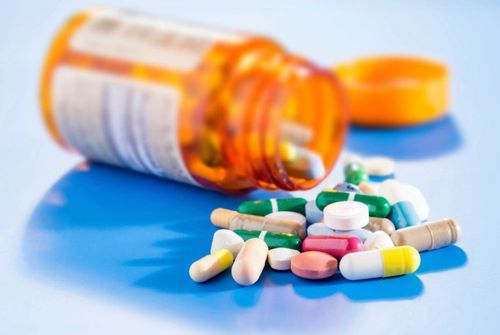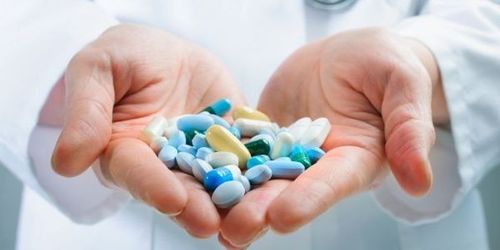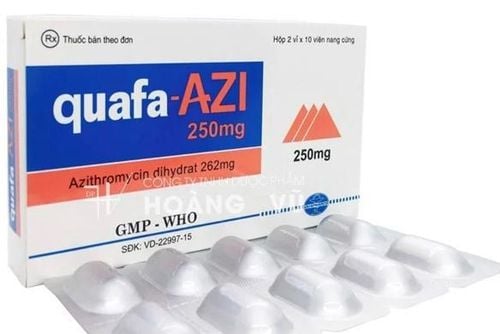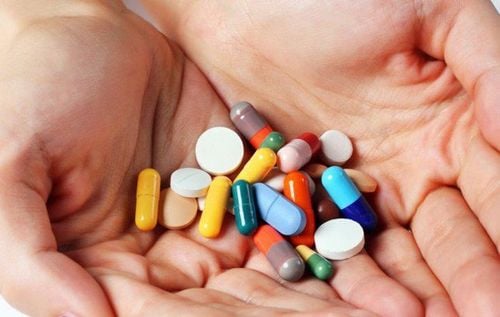This is an automatically translated article.
Cefixime is an antibiotic with good activity against gram-negative bacteria, is relatively stable to beta lactamases and can achieve bactericidal concentrations in the cerebrospinal fluid. However, on gram-positive bacteria, cefixime is less effective than first-generation penicillins and cephalosporins. This is also the main active ingredient in Cefimbrano 100.
1. What is Cefimbrano 100?
Cefimbrano 100 is a product of Vidipha Pharmaceuticals. Cefimbrano 100 contains the main active ingredient, Cefixim, 100mg - this is a 3rd generation cephalosporin antibiotic used to treat infections caused by bacteria that are still sensitive to antibiotics. Cefimbrano 100 is available in powder form.
Cefixim contained in the drug Cefimbrano 100 is a 3rd generation cephalosporin antibiotic used orally for bactericidal action. The bactericidal mechanism of the antibiotic cefixime is similar to that of the cephalosporins, except that the drug binds to target proteins that inhibit the synthesis of mucopeptides in the bacterial cell wall. The mechanism of bacterial resistance to cefixime is formed by reducing the pressure of the cefixime on the target protein or reducing the permeability of the bacterial cell membrane to cefixime causing antibiotic resistance.
Cefixime is an antibiotic with high stability to the hydrolysis of beta-lactamases encoded by genes located on plasmids and cromosomes, the stability to beta lactamases of cefixime is higher than other antibiotics of the same group such as cefaclor, cefoxitin, cefuroxime, cephalexin, cephradine.
After taking a single dose of the antibiotic cefixime, only 30-50% of the dose is absorbed from the gastrointestinal tract whether taken before or after meals. However, in general, the rate of drug absorption can be reduced when the patient takes the drug with a meal. Peak plasma concentrations of Cefixime are 2 micrograms/ml (for a 20 mg dose) and 3.7 micrograms/ml (for a 400 mg dose of cefixime), which is usually reached about 2 to 6 hours after oral dosing.
The half-life of Cefixim is approximately 3 - 4 hours and may be prolonged in patients with renal impairment. Approximately 65% of the antibiotic cefixime in the blood is bound to plasma proteins. Cefimbrano 100 can cross the placenta. Cefixime drug can achieve relatively high concentrations in bile and urine, 20% of an oral dose of Cefixime is excreted unchanged in the urine in 24 hours, 60% of an oral dose of Cefixime is eliminated by the kidneys. Cefixime cannot be removed by hemodialysis.
2. Indications of the drug Cefimbrano 100
Cefimbrano 100 is indicated for use in the following cases:
Cefimbrano 100 is used to treat uncomplicated urinary tract infections caused by susceptible strains such as E.coli or Proteus mirabilis, and in rare cases of infections. caused by Gram-negative bacilli such as Citrobacter spp., Enterobacter spp., Klebsiella spp., Proteus spp... Cefimbrano 100 is indicated for severe pyelonephritis - pyelonephritis, complicated urinary tract infections caused by susceptible Enterobacteriaceae. ; Uses of Cefimbrano 100 to treat otitis media caused by Haemophilus influenzae (including beta-lactamase-producing strains), Moraxella catarrhalis, Streptococcus pyogenes... Treatment of pharyngitis and tonsillitis caused by Streptococcus pyogenes. Cefimbrano 100 medicine is used to treat acute and chronic bronchitis caused by Streptococcus pneumoniae, Haemophilus influenzae, Moraxella catarrhalis, mild and moderate community-acquired pneumonia. Cefimbrano 100 is used to treat uncomplicated gonorrhea caused by Neisseria gonorrhoeae (including beta-lactamase-producing strains); Treatment of typhoid fever caused by Salmonella typhi (including multidrug-resistant strains). Treatment of dysentery caused by susceptible Shigella (including strains resistant to ampicillin).
3. Dosage and how to use Cefimbrano 100
Cefimbrano 100 is used orally with the following dosage:
Adults: Usually take Cefimbrano 100 with a dose of 400mg/day (4 packs/day), which can be taken once or divided into 2 times 12 hours apart. Treatment of uncomplicated gonorrhea caused by Neisseria gonorrhoeae (including beta-lactamase-producing strains): Oral 400mg (single time, can be combined with an antibiotic effective against Chlamydia. (1 time 800mg) is also used to treat gonorrhea With disseminated gonorrhea treated with injections of ceftriaxone, cefotaxime, ceftizoxime or spectinomycin: at this time, the dose of Cefimbrano 100 for adults is: 400mg orally, 2 times a day, orally for 7 days Children > 12 years old or children weighing > 50kg: Use the same dose of Cefimbrano 100 as adults Children 6 months - 12 years old: 8mg/kg/day, take Cefimbrano 100 once a day or can be divided into 2 doses, each time 12 hours apart. Duration of treatment with Cefimbrano 100: Depending on the type of infection, it is recommended to extend Cefimbrano 100 for an additional 48 - 72 hours after the symptoms of infection have disappeared.
The usual duration of Cefimbrano 100 treatment for uncomplicated urinary tract infections and upper respiratory tract infections is 5. – 10 days; Lower respiratory tract infections and otitis media: Cefimbrano 100 treatment for 10-14 days. If uncomplicated urinary tract infections and upper respiratory tract infections caused by beta-hemolytic Streptococcus group A: Cefimbrano 100 should be treated for at least 10 days to prevent rheumatic fever. Patients with renal failure use Cefimbrano 100 as follows:
People with creatinine clearance exceeding 60ml/min: No dose adjustment of Cefimbrano 100 is required. People with creatinine clearance equal to or less than 60ml/min: The dose of Cefimbrano 100 and the number of times of administration must be adjusted according to the degree of renal impairment. Creatinine clearance 21-60ml/min: 300mg/day, Creatinine clearance <20ml/min: Dose of cefixime 200mg/day. Cefixime is not lost through hemodialysis, therefore patients on hemodialysis and peritoneal dialysis do not need additional doses of cefixime. What to do in case of an overdose of Cefimbrano 100?
When overdose of Cefimbrano 100 drug may have convulsive symptoms, currently there is no specific treatment for Cefixime overdose, so treatment is mainly symptomatic. Cefimbrano 100 must be stopped immediately and managed as follows: Gastric lavage, anticonvulsants if indicated, Do not undergo hemodialysis or peritoneal dialysis in case of an overdose of Cefimbrano 100.
4. Side effects of the drug Cefimbrano 100
Common side effects of Cefimbrano 100:
Digestive system: Diarrhea, abdominal pain, vomiting, flatulence, loss of appetite, dry mouth, digestive disorders usually occur in the first 1-2 days of treatment. Gastrointestinal disturbances can respond to symptomatic drugs, so Cefimbrano 100 should rarely be discontinued. Neurological: Headache, fatigue, dizziness, restlessness, insomnia; Hypersensitivity reactions: erythema, urticaria, drug fever. Rare side effects of Cefimbrano 100:
Digestive system: Severe diarrhea due to Clostridium difficile infection, pseudomembranous colitis. Systemic: Anaphylaxis, angioedema, Steven-Johnson, erythema multiforme, toxic epidermal necrolysis. Hematology: Thrombocytopenia, transient eosinophilia, decreased hemoglobin and hematocrit levels; Liver: Hepatitis and jaundice, transient increases in AST, ALT, alkaline phosphatase, bilirubin and LDH. Renal: Acute renal failure ; Genitourinary: Vaginal candidiasis.
5. Contraindications of the drug Cefimbrano 100
Cefimbrano 100 is contraindicated in the following cases:
History of hypersensitivity to cefixime antibiotics or other cephalosporin antibiotics. Anaphylaxis due to penicillin.
6. Use caution when using Cefimbrano 100 for these subjects
Caution when using Cefimbrano 100 for the following subjects:
Cross hypersensitivity between antibiotics of the same group of beta - lactams. History of gastrointestinal disease and colitis; Patient must drive and operate machinery; There are no adequate data on the use of Cefimbrano 100 during pregnancy, so use only when clearly needed; It is not known with certainty whether cefixime is distributed into breast milk, therefore nursing mothers should be cautious when using Cefimbrano 100, may discontinue breast-feeding while taking Cefimbrano 100.
7. Drug interactions of the drug Cefimbrano 100
Probenecid increases the peak concentration and AUC of cefixime contained in Cefimbrano 100, thereby reducing renal clearance and volume of distribution of the drug. Co-administration of Cefimbrano 100 with anticoagulants such as warfarin may increase prothrombin time, with or without bleeding. Cefimbrano 100 increases the plasma concentration of carbamazepine when co-administered. Nifedipine increases the bioavailability of Cefimbrano 100 when co-administered, as demonstrated by increased peak concentrations and increased AUC. Cefimbrano 100 is a product of Vidipha Pharmaceuticals. Cefimbrano 100 contains the main active ingredient, Cefixim, 100mg - this is a 3rd generation cephalosporin antibiotic used to treat infections caused by bacteria that are still sensitive to antibiotics. To ensure effective treatment and avoid unwanted side effects, patients need to strictly follow the instructions of the doctor, professional pharmacist.
Follow Vinmec International General Hospital website to get more health, nutrition and beauty information to protect the health of yourself and your loved ones in your family.
Please dial HOTLINE for more information or register for an appointment HERE. Download MyVinmec app to make appointments faster and to manage your bookings easily.













